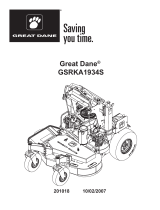
• K ee p hands and feet a w a y from the cutting
units .
• Nev er car r y passeng ers and k ee p pets and
b ystanders a w a y .
• Be aler t, slo w do wn and use caution when
making tur ns . Look behind and to the side
before c hanging directions .
• Slo w do wn and use caution when crossing
roads and sidew alks . Stop blades if not
mo wing .
• Be a w are of the mo w er disc harg e direction and
do not point it at any one .
• Do not operate the mo w er under the influence
of alcohol or dr ugs .
• Use extreme care when loading or unloading
the mac hine into a trailer or tr uc k.
• Use care when approac hing blind cor ners ,
shr ubs , trees , or other objects that ma y obscure
vision.
Slope Operation
• Do not mo w slopes g reater than 15 deg rees .
• Do not mo w near drop-offs , ditc hes , stee p
banks or w ater . W heels dropping o v er edg es
can cause rollo v ers , whic h ma y result in serious
injur y , death or dro wning .
• Do not mo w slopes when g rass is w et. Slipper y
conditions reduce traction and could cause
sliding and loss of control.
• Do not mak e sudden tur ns or rapid speed
c hang es .
• Use a w alk behind mo w er and/or a hand
trimmer near drop-offs , ditc hes , stee p banks
or w ater .
• R educe speed and use extreme caution on
slopes .
• R emo v e or mark obstacles suc h as roc ks , tree
limbs , etc . from the mo wing area. T all g rass
can hide obstacles .
• W atc h for ditc hes , holes , roc ks , dips , and rises
that c hang e the operating angle , as rough
ter rain could o v er tur n the mac hine .
• A v oid sudden star ts when mo wing uphill
because the mo w er ma y tip bac kw ards .
• Be a w are that loss of traction ma y occur g oing
do wnhill. W eight transfer to the front wheels
ma y cause dri v e wheels to slip and cause loss
of braking and steering .
• Alw a ys a v oid sudden star ting or stopping on
a slope . If tires lose traction, diseng ag e the
blades and proceed slo wly off the slope .
• F ollo w the man ufacturer’ s recommendations
for wheel w eights or counterw eights to
impro v e stability .
• Use extreme care with g rass catc hers or other
attac hments . T hese can c hang e the stability of
the mac hine and cause loss of control.
Maintenance and storage
• Diseng ag e dri v es , lo w er implement, set
parking brak e , stop engine and remo v e k ey
or disconnect spark plug wire . W ait for all
mo v ement to stop before adjusting, cleaning
or re pairing .
• Clean g rass and debris from cutting units ,
dri v es , m ufflers , and engine to help prev ent
fires . Clean up oil or fuel spillag e .
• Let engine cool before storing and do not store
near flame .
• Shut off fuel while storing or transpor ting . Do
not store fuel near flames or drain indoors .
• P ark mac hine on lev el g round. Nev er allo w
untrained personnel to ser vice mac hine .
• Use jac k stands to suppor t components when
required.
• Carefully release pressure from components
with stored energ y .
• Disconnect batter y or remo v e spark plug wire
before making any re pairs . Disconnect the
neg ati v e ter minal first and the positi v e last.
R econnect positi v e first and neg ati v e last.
• Use care when c hec king blades . W rap the
blade(s) or w ear glo v es , and use caution when
ser vicing them. Only re place blades . Nev er
straighten or w eld them.
• K ee p hands and feet a w a y from mo ving par ts .
If possible , do not mak e adjustments with the
engine r unning .
• Charg e batteries in an open w ell v entilated
area, a w a y from spark and flames . Unplug
c harg er before connecting or disconnecting
from batter y . W ear protecti v e clothing and use
insulated tools .
5




























